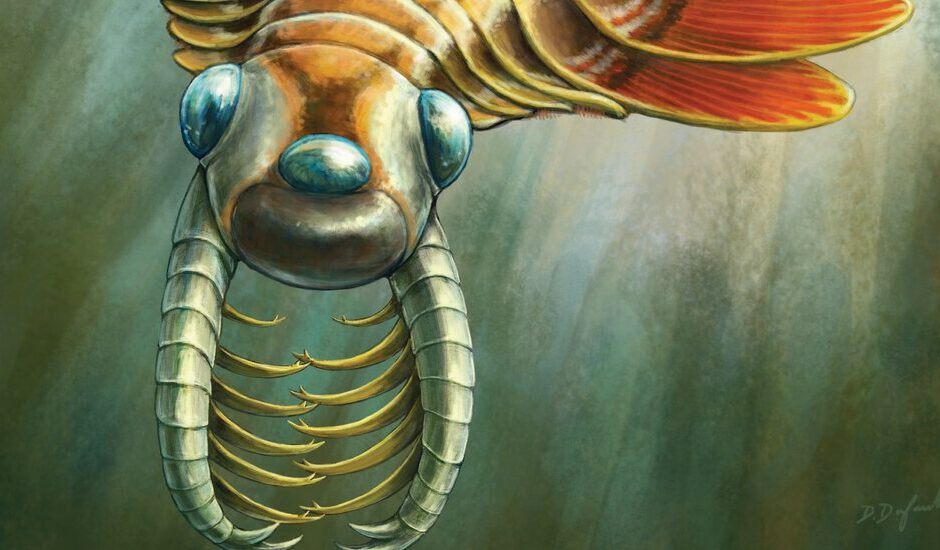More than 500 million years before Matt Groening and “The Simpsons” introduced us to Blinky, a mutated fish with an extra eye swimming through Springfield’s Old Fishin’ Hole, a three-eyed predator chased prey through seas of the Cambrian Period. Once it caught its quarry, a pair of spine-covered grasping claws and a circular mouth covered in teeth would finish the job.
Known as Mosura fentoni, this creature is a worthy addition to the bizarre bestiary preserved in the Burgess Shale, a substantial fossil deposit in the Canadian Rockies. However, the animal’s anatomy, described Wednesday in the journal Royal Society Open Science, reveals that Mosura may not be as alien as it looks.
The first Mosura specimen was unearthed more than a century ago by the paleontologist Charles Walcott, who discovered the Burgess Shale in 1909. Over recent decades, paleontologists at the Royal Ontario Museum in Toronto have uncovered dozens of additional Mosura fossils, which they nicknamed “sea moths” because of flaps on the critters that help them swim and that look similar to wings.
They were not fish, but it was clear that sea moths were related to radiodonts, a group of ancestral arthropods that dominated Cambrian food chains. But a closer inspection of the animal would not happen until a trove of Mosura specimens were unearthed in 2012 in Marble Canyon, a Burgess Shale outcrop.
“Having this collection of both old and new specimens kicked us into gear to finally figure this animal out,” said Joseph Moysiuk, a paleontologist who studied the Marble Canyon fossils as a doctoral student.
Dr. Moysiuk teamed up with his adviser at the Royal Ontario Museum, Jean-Bernard Caron, to examine some 60 sea moth specimens. Like other Burgess Shale creatures, many Mosura specimens were well preserved, retaining features like digestive tracts and circulatory systems. Some even possessed traces of nerve bundles in each of the creature’s three eyes.
The team photographed the Mosura specimens under polarized light to capture the detailed anatomy of the flattened fossils.
A defining feature of living arthropods is the division of their bodies into specialized parts. For example, crustaceans like crabs have different appendages adapted to perform certain functions like feeding or walking. Fossils of many early arthropod ancestors, including other radiodonts, reveal relatively simple body plans. Researchers have therefore long proposed that segmentation took a long time to evolve.
Mosura bucks this trend. Despite measuring only 2.5 inches long, the creature’s body was divided into as many as 26 segments.
“It’s something that we’ve never seen in this group of animals before,” said Dr. Moysiuk, who is now at the Manitoba Museum in Winnipeg, “not just in terms of the large number of segments, but also in terms of how they’re differentiated from other parts of the body.”
In addition to its wide swimming flaps, the animal possessed a highly segmented trunk at the back of its body brimming with gills. According to the researchers, this region resembles the abdomenlike structures that horseshoe crabs, woodlice and some insects use to breathe.
Optimizing its intake of oxygen would have been vital for an active predator like Mosura. The researchers posit that the animal chased tiny prey through the open water. It also most likely had to dart away from larger contemporaries like the two-foot-long Anomalocaris or the spaceship-shaped Titanokorys.
Because no other radiodont possessed such a specialized trunk, the researchers placed Mosura within its own group. And instead of naming the animal after that three-eyed cartoon fish, the team drew inspiration from another pop culture reference, Mothra, Godzilla’s winged nemesis. According to Dr. Moysiuk, the name is a nod both to the creature’s nickname and to the enduring popularity of Burgess Shale critters in Japan.
The team observed other noteworthy features in Mosura, including dark, reflective patches within the creature’s body and swim flaps. The researchers posit that these represent lacunae: internal cavities that held the animal’s blood after it was pumped out of its tubelike heart.
However, not all researchers are convinced that these marks represent fossilized blood pouches. According to Joanna Wolfe, a paleontologist at Harvard University who was not involved in the new paper, they could represent other features, like gut glands.
While some of Mosura’s features may be up for scientific debate, Dr. Caron thinks the body segments of this ancient sea creature make clear its connection with living arthropods. “It’s a very strange animal indeed,” he said, “but maybe not necessarily as strange as it initially looks.”
#Fossils #Eyes #Surprising #Feature


